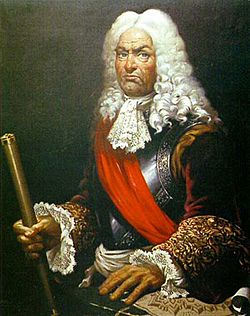Marquis of Verboom facts for kids
Quick facts for kids
The Marquess of Verboom
|
|
|---|---|
 |
|
| Personal details | |
| Born |
George Prosper Verboom
9 January 1665 Brussels, Spanish Netherlands |
| Died | 19 January 1744 (aged 79) Barcelona, Kingdom of Spain |
| Occupation | Military engineer |
| Military service | |
|
|
|
| Allegiance | |
| Branch | |
| Wars | |
Jorge Próspero de Verboom (born January 9, 1665 – died January 19, 1744) was a very important military engineer from Flanders. He worked for the King of Spain. A military engineer helps design and build forts, bridges, and other structures needed for armies. King Philip V of Spain gave him the special title of Marquess of Verboom in 1727.
Contents
Early Life and Training
Jorge Próspero de Verboom was born in Brussels, which was then part of the Spanish Netherlands. His father, Cornelius Verboom, was also a famous engineer. Cornelius was in charge of building strong defenses for cities like Besançon and Dôle in France.
Young Jorge followed in his father's footsteps. He joined the Spanish Military Engineering Academy in Brussels. There, he learned from Alferez Sebastián Fernández de Medrano, who was the director of the academy. This training helped him become a skilled engineer.
Military Career and Key Battles
Jorge Próspero de Verboom played a big role in many important wars and sieges. A "siege" is when an army surrounds a city or fort to try and capture it.
Nine Years' War
During the Nine Years' War, Verboom showed his skills. In 1691, he helped William III of Orange in a campaign against the French army near Mons. Later, in 1695, he helped lead the siege of Namur alongside a Dutch military engineer named Menno van Coehoorn.
Because of his success, Verboom was promoted to a high rank. He became a field marshal in the Spanish cavalry. Two years later, he was put in command of the Lorraine Regiment of Cavalry.
War of the Spanish Succession
Verboom was very active during the Spanish War of Succession. In 1702, he was in charge of defending the city of Antwerp. He also took part in the siege of Hulst.
In 1706, the French and Spanish armies faced a big defeat at the Battle of Ramillies. This battle was against troops led by the Duke of Marlborough. After this, Verboom's troops from Antwerp were used to put pressure on the British army at the siege of Termonde.
In 1709, Verboom was asked to check on the condition of castles and army bases along the border between Spain and Portugal. This shows how much the King trusted his engineering knowledge.
Promotion and Capture
On December 18, 1709, Verboom was promoted to lieutenant general. Just a few days later, he became the engineer general of all the Royal Armies. This meant he was in charge of all engineering work for the King's armies, towns, and forts, no matter where they were located.
In 1710, he fought in the Battle of Almenar against Count Guido Starhemberg. During this battle, Verboom was captured by the enemy. He was held prisoner until 1712.
Work in Barcelona
After being released, Verboom played a very active part in the capture of Barcelona. After Barcelona was taken, he moved there in 1718. He then oversaw the building of the Ciudadela of Barcelona, a large fortress designed to protect the city. He also helped plan for the War of the Quadruple Alliance, which aimed to get back Sardinia and Sicily for Spain.
Between 1737 and 1738, he even took on the important role of acting Captain General of Catalonia. This meant he was temporarily in charge of the entire region.
Later Life and Legacy
Jorge Próspero de Verboom passed away on January 19, 1744, at the age of 79. He was buried at the Real Convento de Santa Catalina. He is remembered as a key figure in Spanish military engineering and for his contributions to many important conflicts and fortifications.
See also


